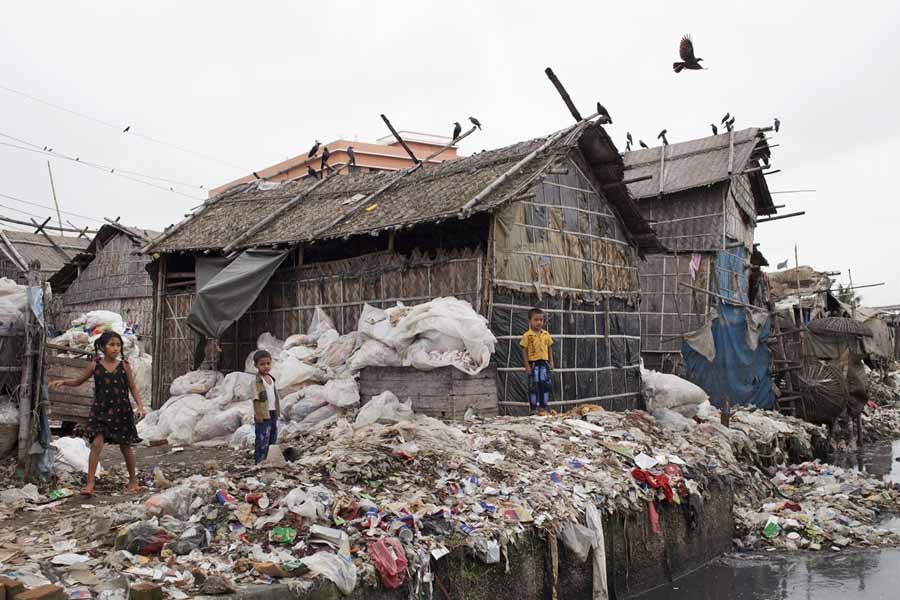Villages in Bangladesh were once viewed as epitome of everything pure and genuine. The sylvan charm pervading the rural landscape and its people used to be a favourite subject of songs, poetry and other cultural expressions. Those days seem to be disappearing fast. In the last few decades, villages have shown signs that they are going the cities' way, with urban pollutions insidiously making inroads into rural expanses. It seems it may not be possible for nostalgic people to hark back any more to the Bangladesh of even the 1930s and 40s. In a densely populated small country like Bangladesh, the encroachment of urban scourges at some point of time emerges as the bitter reality. Strong administrative measures coupled with people's awareness could keep these adversities at bay. Unfortunately, it does not always happen.
In the 21st century, it seems that the country has failed in all the village-friendly tasks. Ironically, there has been no dearth of rhetoric. With the air, land and water of the once-idyllic villages being filled with harmful alien maladies, life in rural Bangladesh is not the same as it was even a couple of decades ago. Widespread pollution calls the shot in villages, and the process has gained an alarming speed lately.
Remote villages are still free of the scourges of big fires, let alone chemical-induced killer blazes. But few can deny outright that factories with the dread of causing toxic fire and emissions are not operating clandestinely in areas close to small towns. On a broader scale, air pollution has in the recent years become pervasive in villages. Thanks to the mushrooming brick kilns, rice mills and other smoke-spewing factories, the air of rural Bangladesh has long become a threat to the health of people living in the surrounding areas. Environmental hazards were once something unheard-of in villages. They are now part and parcel of their lives. At present the defiant brick kiln owners are considered the most terrible of the rogue elements vitiating the rural air. Apart from humans, it is the croplands that bear the greatest brunt of brick field pollution. Owing to the easy availability of soil, the top soil in particular, brick kilns are seen being normally set up adjacent to the crop fields. To meet the requirement of fuels for baking bricks, nearby forests turn out to be the easy targets.
In order to set up a brick kiln, a person has to take permission, in the form of a licence, from the Department of Environment (DoE). But kilns operating without mandatory permissions are a common spectacle in the present rural Bangladesh. Formal complaints are lodged by the affected farmers. But they fall on deaf ears. Few remedial measures are seen to have been taken. The ferocity of the encroachment of brick kilns has been on an alarming increase in the country. Even few small villages can now be found that do not have at least a couple of these kilns. Upon regular surveys, upazilas having kilns are found to be on the continued rise. Thirty to forty brick kilns are located on average in areas under the jurisdiction of an upazila . They are both legal and illegal. In the northern Lalmonirhat upazila, there are 47 brick fields in total. Of them 20 received formal nod of the DoE. The rest are running without legal papers, that too on crop fields. Repeated protests and formal complaints by the villagers proved futile. The illegal kilns continue to operate in full gear. Apart from the brick fields in operation in relatively remote areas, there are scores of such kilns on the banks of Dhaleshwari and Meghna in greater Dhaka. In short, brick kilns now play the greatest role in the country's rural air pollution.
Tree felling continues unabated in villages. With trees gone, dust-laden soil becomes exposed hazardously. Like in the urban Dhaka, dust pollution during windy seasons plagues villagers these days. This was beyond the furthest stretch of imagination of the rural people. With dust floating in the air, myriad types of lung-related and respiratory health hazards continue to afflict the rural population. Bangladesh villages were once synonymous with serenity and blissful quiet. Those have long vanished. With motorbikes and improvised vehicles plying the roads --- approved and unauthorised, in villages the chirping of birds and the noise of frolicking children are getting buried. In Bangladesh, there are now hundreds of villages near commercial centres, where the motor vehicle-emitting noise continues to overwhelm the age-old buzz of rural environment. The sound of roaring vehicles at times reaches such a high pitch that the moo of cows or the crow of cocks in an idle summer noon often becomes inaudible.
Besides, there are the noise-filled ubiquitous engine boats. Villages located near the banks of rivers and canals continue to be afflicted by the annoying sound produced by these improvised boats and small trawlers. The unsightly scenario and the sound pollution caused by these so-called boats stand in sharp contrast to the centuries-old rural view: Country boats moving languidly manoeuvred by colourful sails or the rowing crew interspersed by plaintive folk songs of the boatmen. Even water is fast turning polluted with pesticides and chemical fertilisers being washed away into the rivers, canals etc during floods. With so many pollutions encroaching on the village expanses, the rural Bangladesh may not be eligible to remain included in the areas free of environmental hazards.


